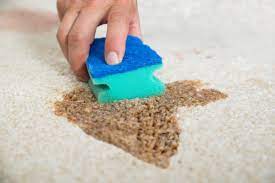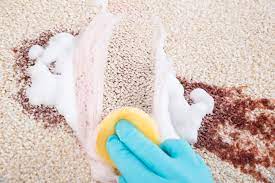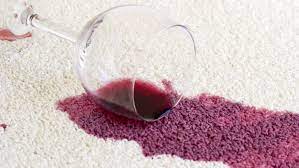Spills and stains, those unexpected guests in the realm of daily life, can quickly turn routine moments into challenges. For households bustling with the energy of children and the companionship of pets, these uninvited marks are all too familiar. Yet, the seemingly straightforward task of stain removal is an intricate dance that demands more than just a cloth and cleaning solution. It requires a blend of science, strategy, and skill to undo the damage without causing further harm. To guide you through this delicate art, we’ve curated an essential set of stain-busting guidelines.
Essential Tools for Successful Stain Removal
1. Beware of Hot Water: Imagine confronting a fresh stain armed with a vessel of hot water. Intuitively, it appears to be a potent solution. However, in some cases, hot water can be a counterproductive foe. Stains rooted in proteins, like the notorious blood stain, can be set permanently by the application of heat. Instead, opt for the soothing touch of cold water to prevent this inadvertent fixation.
2. Gentle Dabbing Over Frantic Rubbing: When confronted with an obstinate stain, the instinct to rub it away fervently is difficult to suppress. Yet, this haste can aggravate the situation, causing the stain to spread further and potentially damaging the fabric’s weave. Embrace the elegance of gentle dabbing—a technique that addresses the stain while preserving the textile’s structural integrity.
 3. The Goldilocks Rule for Stain Removers: The adage “less is more” holds true in the realm of stain removal. Drenching a stain in excess remover might seem like a panacea, but it can render the area resistant to rinsing and drying. Delicate surfaces, such as carpets and upholstery, are especially susceptible to this saturation. Instead, opt for a measured, iterative approach, applying small quantities of remover at intervals to achieve optimal results.
3. The Goldilocks Rule for Stain Removers: The adage “less is more” holds true in the realm of stain removal. Drenching a stain in excess remover might seem like a panacea, but it can render the area resistant to rinsing and drying. Delicate surfaces, such as carpets and upholstery, are especially susceptible to this saturation. Instead, opt for a measured, iterative approach, applying small quantities of remover at intervals to achieve optimal results.
 4. Vigilance against Soap on Fresh Stains: In the initial moments of stain discovery, the lure of soap is undeniable. However, not all soaps are created equal, and some can inadvertently set stains—particularly those adorned with pigments like coffee, red wine, and tea. To circumvent this paradoxical outcome, embark on your stain-removal journey with a comprehensive rinse using cold water.
5. Red Wine and Salt: A Misconception Dispelled: The folklore surrounding salt’s efficacy in vanquishing red wine stains persists, but it’s a fallacy. Rather than being a remedy, salt can solidify the stain’s presence. This principle extends to stains from coffee, tea, and cola as well. Embrace a wiser strategy: promptly rinse the stain with cold water and enlist the aid of specialized stain removers, such as the acclaimed Wine No More!.
4. Vigilance against Soap on Fresh Stains: In the initial moments of stain discovery, the lure of soap is undeniable. However, not all soaps are created equal, and some can inadvertently set stains—particularly those adorned with pigments like coffee, red wine, and tea. To circumvent this paradoxical outcome, embark on your stain-removal journey with a comprehensive rinse using cold water.
5. Red Wine and Salt: A Misconception Dispelled: The folklore surrounding salt’s efficacy in vanquishing red wine stains persists, but it’s a fallacy. Rather than being a remedy, salt can solidify the stain’s presence. This principle extends to stains from coffee, tea, and cola as well. Embrace a wiser strategy: promptly rinse the stain with cold water and enlist the aid of specialized stain removers, such as the acclaimed Wine No More!.
 6. Chemical Compatibility Matters: Imagine stain removal as a symphony of chemicals. Mixing disparate stain removal products can yield disharmonious and even hazardous outcomes due to unexpected chemical reactions. The implications of such incompatibility, especially when chlorine bleach and ammonia are involved, can encompass the creation of lethal chlorine gas.
6. Chemical Compatibility Matters: Imagine stain removal as a symphony of chemicals. Mixing disparate stain removal products can yield disharmonious and even hazardous outcomes due to unexpected chemical reactions. The implications of such incompatibility, especially when chlorine bleach and ammonia are involved, can encompass the creation of lethal chlorine gas.
 7. A Cautionary Note on Enzyme-Based Products: Enzymes, nature’s molecular craftsmen, excel at breaking down protein fibres. However, this power becomes a liability when applied to delicate fabrics like silk and wool. The vulnerable nature of these fibres means they can succumb to the degrading effects of enzymes. To safeguard your treasured garments, opt for non-enzyme products and detergents crafted specifically for delicate materials.
8. Chlorine Bleach and Delicate Fabrics: Chlorine bleach wields unparalleled potency in the stain removal realm, but its application requires caution. Delicate fabrics, including silk and wool, are ill-equipped to withstand the rigors of bleach. As a rule of thumb, exercise scrutiny by assessing the fabric label before introducing bleach. To preserve beloved garments, explore alternative stain removal methods.
9. Respect for Antique Fabrics: Antique textiles carry within their threads the echoes of history, and their fragility demands a gentle touch. Inexpert stain removal attempts can exacerbate damage rather than reverse it. To honour these historical treasures, entrust their restoration to professionals possessing the expertise and tools needed to ensure their preservation.
10. Persistence Pays Off: In the realm of stain removal, patience is the unsung hero. Certain stains demand time and tenacity, often necessitating repeated attempts before surrendering. Confronted with these resilient marks, maintaining your persistence is key. By doggedly repeating the removal process, you’ll inch closer to the desired outcome.
Within the canvas of everyday life, stains emerge as both nuisances and opportunities for mastery. Armed with the blueprint provided by Poppies stain-busting guidelines, you can confidently embark on the journey to flawless fabrics. Evade the pitfalls detailed above, and embark on your stain-removal adventure armed with knowledge and finesse. By navigating the intricacies of fabric types, wielding precise techniques, and embracing the virtue of patience, you can transform a stain-ridden predicament into a triumph of restoration. While stains are an inevitability, the power to conquer them is the hallmark of a true household virtuoso.
7. A Cautionary Note on Enzyme-Based Products: Enzymes, nature’s molecular craftsmen, excel at breaking down protein fibres. However, this power becomes a liability when applied to delicate fabrics like silk and wool. The vulnerable nature of these fibres means they can succumb to the degrading effects of enzymes. To safeguard your treasured garments, opt for non-enzyme products and detergents crafted specifically for delicate materials.
8. Chlorine Bleach and Delicate Fabrics: Chlorine bleach wields unparalleled potency in the stain removal realm, but its application requires caution. Delicate fabrics, including silk and wool, are ill-equipped to withstand the rigors of bleach. As a rule of thumb, exercise scrutiny by assessing the fabric label before introducing bleach. To preserve beloved garments, explore alternative stain removal methods.
9. Respect for Antique Fabrics: Antique textiles carry within their threads the echoes of history, and their fragility demands a gentle touch. Inexpert stain removal attempts can exacerbate damage rather than reverse it. To honour these historical treasures, entrust their restoration to professionals possessing the expertise and tools needed to ensure their preservation.
10. Persistence Pays Off: In the realm of stain removal, patience is the unsung hero. Certain stains demand time and tenacity, often necessitating repeated attempts before surrendering. Confronted with these resilient marks, maintaining your persistence is key. By doggedly repeating the removal process, you’ll inch closer to the desired outcome.
Within the canvas of everyday life, stains emerge as both nuisances and opportunities for mastery. Armed with the blueprint provided by Poppies stain-busting guidelines, you can confidently embark on the journey to flawless fabrics. Evade the pitfalls detailed above, and embark on your stain-removal adventure armed with knowledge and finesse. By navigating the intricacies of fabric types, wielding precise techniques, and embracing the virtue of patience, you can transform a stain-ridden predicament into a triumph of restoration. While stains are an inevitability, the power to conquer them is the hallmark of a true household virtuoso.
 3. The Goldilocks Rule for Stain Removers: The adage “less is more” holds true in the realm of stain removal. Drenching a stain in excess remover might seem like a panacea, but it can render the area resistant to rinsing and drying. Delicate surfaces, such as carpets and upholstery, are especially susceptible to this saturation. Instead, opt for a measured, iterative approach, applying small quantities of remover at intervals to achieve optimal results.
3. The Goldilocks Rule for Stain Removers: The adage “less is more” holds true in the realm of stain removal. Drenching a stain in excess remover might seem like a panacea, but it can render the area resistant to rinsing and drying. Delicate surfaces, such as carpets and upholstery, are especially susceptible to this saturation. Instead, opt for a measured, iterative approach, applying small quantities of remover at intervals to achieve optimal results.
 4. Vigilance against Soap on Fresh Stains: In the initial moments of stain discovery, the lure of soap is undeniable. However, not all soaps are created equal, and some can inadvertently set stains—particularly those adorned with pigments like coffee, red wine, and tea. To circumvent this paradoxical outcome, embark on your stain-removal journey with a comprehensive rinse using cold water.
5. Red Wine and Salt: A Misconception Dispelled: The folklore surrounding salt’s efficacy in vanquishing red wine stains persists, but it’s a fallacy. Rather than being a remedy, salt can solidify the stain’s presence. This principle extends to stains from coffee, tea, and cola as well. Embrace a wiser strategy: promptly rinse the stain with cold water and enlist the aid of specialized stain removers, such as the acclaimed Wine No More!.
4. Vigilance against Soap on Fresh Stains: In the initial moments of stain discovery, the lure of soap is undeniable. However, not all soaps are created equal, and some can inadvertently set stains—particularly those adorned with pigments like coffee, red wine, and tea. To circumvent this paradoxical outcome, embark on your stain-removal journey with a comprehensive rinse using cold water.
5. Red Wine and Salt: A Misconception Dispelled: The folklore surrounding salt’s efficacy in vanquishing red wine stains persists, but it’s a fallacy. Rather than being a remedy, salt can solidify the stain’s presence. This principle extends to stains from coffee, tea, and cola as well. Embrace a wiser strategy: promptly rinse the stain with cold water and enlist the aid of specialized stain removers, such as the acclaimed Wine No More!.
 6. Chemical Compatibility Matters: Imagine stain removal as a symphony of chemicals. Mixing disparate stain removal products can yield disharmonious and even hazardous outcomes due to unexpected chemical reactions. The implications of such incompatibility, especially when chlorine bleach and ammonia are involved, can encompass the creation of lethal chlorine gas.
6. Chemical Compatibility Matters: Imagine stain removal as a symphony of chemicals. Mixing disparate stain removal products can yield disharmonious and even hazardous outcomes due to unexpected chemical reactions. The implications of such incompatibility, especially when chlorine bleach and ammonia are involved, can encompass the creation of lethal chlorine gas.
 7. A Cautionary Note on Enzyme-Based Products: Enzymes, nature’s molecular craftsmen, excel at breaking down protein fibres. However, this power becomes a liability when applied to delicate fabrics like silk and wool. The vulnerable nature of these fibres means they can succumb to the degrading effects of enzymes. To safeguard your treasured garments, opt for non-enzyme products and detergents crafted specifically for delicate materials.
8. Chlorine Bleach and Delicate Fabrics: Chlorine bleach wields unparalleled potency in the stain removal realm, but its application requires caution. Delicate fabrics, including silk and wool, are ill-equipped to withstand the rigors of bleach. As a rule of thumb, exercise scrutiny by assessing the fabric label before introducing bleach. To preserve beloved garments, explore alternative stain removal methods.
9. Respect for Antique Fabrics: Antique textiles carry within their threads the echoes of history, and their fragility demands a gentle touch. Inexpert stain removal attempts can exacerbate damage rather than reverse it. To honour these historical treasures, entrust their restoration to professionals possessing the expertise and tools needed to ensure their preservation.
10. Persistence Pays Off: In the realm of stain removal, patience is the unsung hero. Certain stains demand time and tenacity, often necessitating repeated attempts before surrendering. Confronted with these resilient marks, maintaining your persistence is key. By doggedly repeating the removal process, you’ll inch closer to the desired outcome.
Within the canvas of everyday life, stains emerge as both nuisances and opportunities for mastery. Armed with the blueprint provided by Poppies stain-busting guidelines, you can confidently embark on the journey to flawless fabrics. Evade the pitfalls detailed above, and embark on your stain-removal adventure armed with knowledge and finesse. By navigating the intricacies of fabric types, wielding precise techniques, and embracing the virtue of patience, you can transform a stain-ridden predicament into a triumph of restoration. While stains are an inevitability, the power to conquer them is the hallmark of a true household virtuoso.
7. A Cautionary Note on Enzyme-Based Products: Enzymes, nature’s molecular craftsmen, excel at breaking down protein fibres. However, this power becomes a liability when applied to delicate fabrics like silk and wool. The vulnerable nature of these fibres means they can succumb to the degrading effects of enzymes. To safeguard your treasured garments, opt for non-enzyme products and detergents crafted specifically for delicate materials.
8. Chlorine Bleach and Delicate Fabrics: Chlorine bleach wields unparalleled potency in the stain removal realm, but its application requires caution. Delicate fabrics, including silk and wool, are ill-equipped to withstand the rigors of bleach. As a rule of thumb, exercise scrutiny by assessing the fabric label before introducing bleach. To preserve beloved garments, explore alternative stain removal methods.
9. Respect for Antique Fabrics: Antique textiles carry within their threads the echoes of history, and their fragility demands a gentle touch. Inexpert stain removal attempts can exacerbate damage rather than reverse it. To honour these historical treasures, entrust their restoration to professionals possessing the expertise and tools needed to ensure their preservation.
10. Persistence Pays Off: In the realm of stain removal, patience is the unsung hero. Certain stains demand time and tenacity, often necessitating repeated attempts before surrendering. Confronted with these resilient marks, maintaining your persistence is key. By doggedly repeating the removal process, you’ll inch closer to the desired outcome.
Within the canvas of everyday life, stains emerge as both nuisances and opportunities for mastery. Armed with the blueprint provided by Poppies stain-busting guidelines, you can confidently embark on the journey to flawless fabrics. Evade the pitfalls detailed above, and embark on your stain-removal adventure armed with knowledge and finesse. By navigating the intricacies of fabric types, wielding precise techniques, and embracing the virtue of patience, you can transform a stain-ridden predicament into a triumph of restoration. While stains are an inevitability, the power to conquer them is the hallmark of a true household virtuoso. Last Update: December 17, 2025




